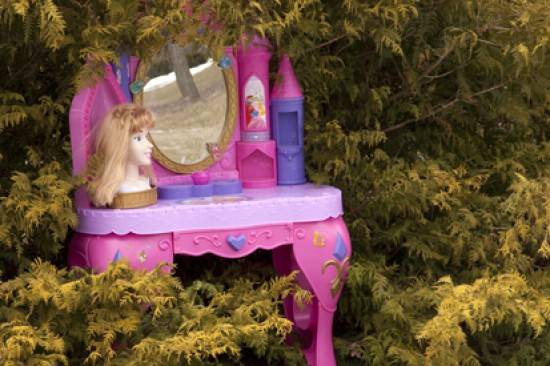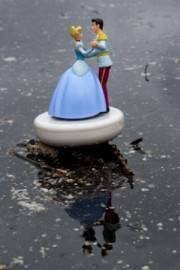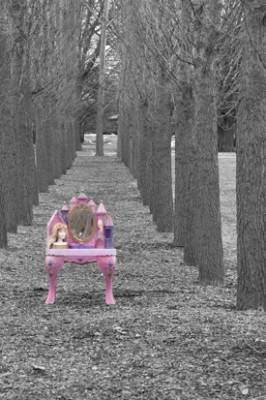Plastic toys are like an infestation of bats. You don’t even notice them biting you in your sleep. They hide in corners and when you finally stumble across one—a brown lump of fur on the wall or between the sheets—you wonder how it got there. I wish my collection of plastic was so unintentional. A case of mistaken indulgence, perhaps.
 For Christmas, my daughter received a Sleeping Beauty makeup desk from her grandparents. It is a three-foot tall, talking, singing, plastic atrocity. She loved it for a day, and now it sits in our basement, a sad leftover.
For Christmas, my daughter received a Sleeping Beauty makeup desk from her grandparents. It is a three-foot tall, talking, singing, plastic atrocity. She loved it for a day, and now it sits in our basement, a sad leftover.
I could give it to someone else; let their daughter love it for a day. I could disassemble it, take out the screws and add them to the coffee tin of screws that also sits in the basement. That would leave a lot of PVC, the type of plastic most toys are made of. PVC is full of toxic chemicals and many people around the world are fighting to have it banned.
I could throw the plastic away and it could end up in the stomachs of baby birds, or in a landfill for my great-great-grandchildren to find; maybe they’ll want to play with it. Or maybe it will end up in the ocean, floating like pink sprinkles on a blue cake. No wonder birds get confused.
How many of those makeup desks do you think sold in the United States during the Christmas holiday? Even if each one of them are re-gifted a hundred times, they are all, inevitably, going to the same place: the trash.
That leads me back to my first idea: giving it away. Of course, this does not guarantee that the next person won’t throw it away, nor does it erase the responsibility I have in the possible end result: dead birds.
In 2010, there still is no way of recycling these plastic toys in Champaign-Urbana. The best we can do is to not buy them. There are plenty of wooden toys out there, some more appealing than others. There is no shame in giving your children used toys—or at least there shouldn’t be. We must take responsibility for our own waste. Imagine the landfill in your own back yard. Would you want it to be full of plastic that will never decompose? I would certainly be taking my dog to the vet more often—he loves to eat plastic things.
There are many stores and agencies in Champaign-Urbana that accept and redistribute used toys, the most successful being those that give them away to the community. These agencies include Empty Tomb, Salt and Light, and some churches. The Crisis Nursery occasionally has a need for used toys also. Feel free to call for details.
Other local agencies accept used toys and then sell them, at very reasonable prices, back to the community. Such organizations include Goodwill and The Salvation Army. These agencies then sell the leftover toys to wholesale recycling companies or ship them to other store locations. Broken toys are thrown away, not because these agencies are wasteful, but because there is nothing else to do with them.
Garage sales and Craigslist are other good choices for getting rid of unused toys and redistributing them locally. But I think it’s more important to start buying from, or shopping at, the above agencies, as opposed to letting your child pick from the shelves at Wal-Mart. This need children have for new toys is something they have learned from us. It’s time to take responsibility for that and begin to change it.
Throw a party for your friends and have everyone bring toys that their kids no longer play with. Serve martinis and send people home with a designated driver and a trunk-full of “new” toys. Call or email toy manufacturers and tell them you want more wooden toys. When I called Disney Corporation to ask if they accepted their own toys for re-use, they transferred me ten times; no one had ever heard of such an absurd thing!
According to their website, the Walt Disney Company has big dreams, or possibly delusions, about its environmental responsibility:
Disney has a long-term vision of achieving zero waste. Meeting the goal will require minimizing waste, increasing and improving aggressive recycling and other disposal mitigation programs, and sourcing high-recycled content and highly recyclable products.
Before you get all warm and fuzzy about that, know that plastic toys cannot be recycled in Champaign-Urbana. And mailing these toys to the Walt Disney Company will do nothing but add to landfills. But maybe if enough people did that, Disney would get the point. I wonder what they mean by “long-term.” Decades? Centuries?
The point is, no matter how many environmental awards these corporations receive, the responsibility is our own. If we weren’t buying these toys, they wouldn’t be making them. We can’t be responsible for what other people do with their toys, or what they do with those that used to be ours, but we can control our buying habits—gifts from grandparents aside—and those of our children.
In 2007, Country Home magazine listed Champaign-Urbana as one of the “greenest” cities in the country. We didn’t make it in the top 25 in 2008. But environmental responsibility isn’t about votes, or tax hikes, or campaign slogans. It’s about us and our children, and it is within our grasp to influence the next generation, and maybe even our own.









